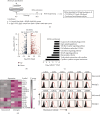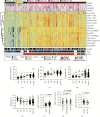Disease-Specific Autoantibodies Induce Trained Immunity in RA Synovial Tissues and Its Gene Signature Correlates with the Response to Clinical Therapy
- PMID: 33082707
- PMCID: PMC7558774
- DOI: 10.1155/2020/2109325
Disease-Specific Autoantibodies Induce Trained Immunity in RA Synovial Tissues and Its Gene Signature Correlates with the Response to Clinical Therapy
Abstract
Much evidence suggests that trained immunity is inappropriately activated in the synovial tissue in rheumatoid arthritis (RA), but the underlying mechanism remains unclear. Here, we describe how RA-specific autoantibody deposits can train human monocytes to exert the hyperactive inflammatory response, particularly via the exacerbated release of tumor necrosis factor α (TNFα). Comparative transcriptomic analysis by plate-bound human IgG (cIgG) or β-glucan indicated that metabolic shift towards glycolysis is a crucial mechanism for trained immunity. Moreover, the cIgG-trained gene signatures were enriched in synovial tissues from patients with ACPA- (anticitrullinated protein antibody-) positive arthralgia and undifferentiated arthritis, and early RA and established RA bore a great resemblance to the myeloid pathotype, suggesting a historical priming event in vivo. Additionally, the expression of the cIgG-trained signatures is higher in the female, older, and ACPA-positive populations, with a predictive role in the clinical response to infliximab. We conclude that RA-specific autoantibodies can train monocytes in the inflamed lesion as early as the asymptomatic stage, which may not merely improve understanding of disease progression but may also suggest therapeutic and/or preventive strategies for autoimmune diseases.
Copyright © 2020 Xiaoli Dai et al.
Conflict of interest statement
The authors declare no conflict of interest related to this work.
Figures







Similar articles
-
Increased expression of Fcgamma receptors II and III on macrophages of rheumatoid arthritis patients results in higher production of tumor necrosis factor alpha and matrix metalloproteinase.Arthritis Rheum. 2003 Apr;48(4):1002-14. doi: 10.1002/art.10871. Arthritis Rheum. 2003. PMID: 12687542
-
Mast cell activation and its relation to proinflammatory cytokine production in the rheumatoid lesion.Arthritis Res. 2000;2(1):65-74. doi: 10.1186/ar70. Arthritis Res. 2000. PMID: 11219391 Free PMC article.
-
Induction of macrophage secretion of tumor necrosis factor alpha through Fcgamma receptor IIa engagement by rheumatoid arthritis-specific autoantibodies to citrullinated proteins complexed with fibrinogen.Arthritis Rheum. 2008 Mar;58(3):678-88. doi: 10.1002/art.23284. Arthritis Rheum. 2008. PMID: 18311806
-
Expression of Toll-like receptor 2 on CD16+ blood monocytes and synovial tissue macrophages in rheumatoid arthritis.Arthritis Rheum. 2004 May;50(5):1457-67. doi: 10.1002/art.20219. Arthritis Rheum. 2004. PMID: 15146415
-
Rheumatoid arthritis: Recent advances on its etiology, role of cytokines and pharmacotherapy.Biomed Pharmacother. 2017 Aug;92:615-633. doi: 10.1016/j.biopha.2017.05.055. Epub 2017 Jun 3. Biomed Pharmacother. 2017. PMID: 28582758 Review.
Cited by
-
KK2DP7 Stimulates CD11b+ Cell Populations in the Spleen to Elicit Trained Immunity for Anti-Tumor Therapy.Adv Sci (Weinh). 2025 Jun;12(23):e2500032. doi: 10.1002/advs.202500032. Epub 2025 Mar 27. Adv Sci (Weinh). 2025. PMID: 40145812 Free PMC article.
-
The value of contrast-enhanced ultrasound in synovial pathotypes of rheumatoid arthritis: an exploratory study.Eur Radiol. 2025 Aug 20. doi: 10.1007/s00330-025-11921-6. Online ahead of print. Eur Radiol. 2025. PMID: 40836017
-
Training vs. Tolerance: The Yin/Yang of the Innate Immune System.Biomedicines. 2023 Mar 2;11(3):766. doi: 10.3390/biomedicines11030766. Biomedicines. 2023. PMID: 36979747 Free PMC article. Review.
-
Glycolysis Rate-Limiting Enzymes: Novel Potential Regulators of Rheumatoid Arthritis Pathogenesis.Front Immunol. 2021 Nov 24;12:779787. doi: 10.3389/fimmu.2021.779787. eCollection 2021. Front Immunol. 2021. PMID: 34899740 Free PMC article. Review.
References
MeSH terms
Substances
LinkOut - more resources
Full Text Sources
Medical
Molecular Biology Databases

